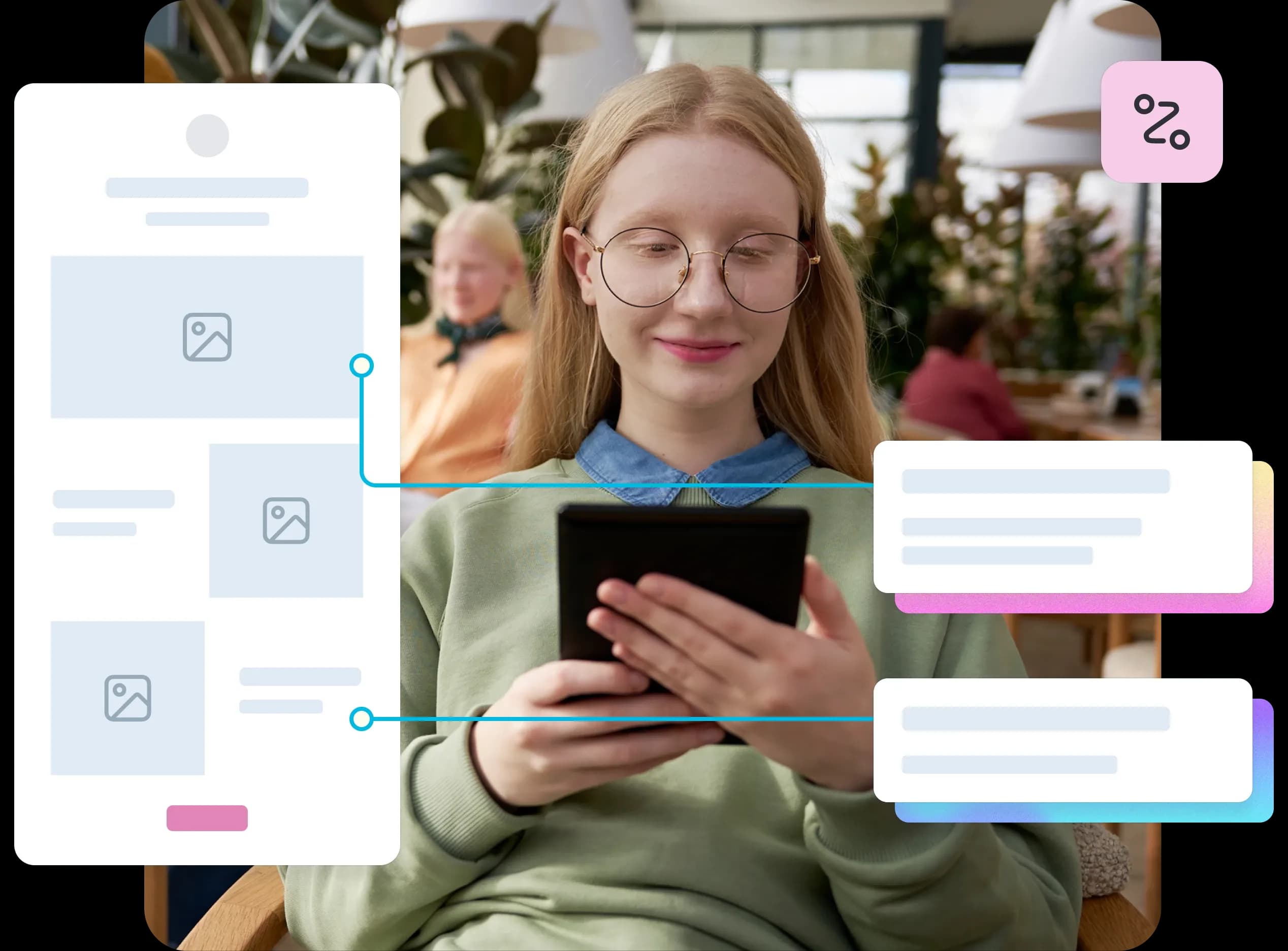Prototype testing guide
Learn what prototype testing is, how to run it, and why it matters for UX. Discover testing methods, step-by-step guides, and best practices to validate designs early.
Prototype testing guide
Testing prototypes early in the design process is one of the most effective ways to validate ideas and catch usability issues before investing in full development.
UX design is an iterative process rooted in solid UX principles. Testing prototypes early and throughout the design process helps ensure you're building a product your users will find useful.
When teams skip prototype testing, they risk building features that don't meet user needs or creating interfaces that confuse rather than guide users.
Here's a common scenario: You design a pet sitting app, then realize people struggle to find sitters in their neighborhood. They can't locate the messaging function. They miss the availability calendar entirely.
Prototype testing helps you catch these fundamental usability issues early. The result? You save time, reduce costs, and create better experiences for your users.
This guide covers everything you need to know about prototype testing:
What it is and why it matters
Different methods you can use
How to implement it effectively in your design process
Key takeaways
Prototype testing validates design decisions early when changes are cheap – fixing issues during design costs less than during implementation.
You can test at any fidelity level, from basic wireframes to detailed interactive prototypes, depending on what you need to learn.
Testing with 5-8 participants reveals most major usability issues, while 15-30 participants provide more quantitative feedback.
The method prevents costly rework by catching fundamental problems before development begins – saving time, money, and resources.
Iterate multiple times throughout the design process rather than expecting to get everything right in a single testing round.
Test your prototypes today
Validate your designs before you build. Sign up for a free Lyssna plan and start testing prototypes with real users in minutes.
What is prototype testing?
Prototype testing is the process of evaluating early versions of a product or feature with real users. The goal is to validate design decisions, identify usability issues, and gather feedback before full development begins.
It involves testing low-fidelity or high-fidelity prototypes with users. This helps you understand:
How they interact with your design concepts
Whether your proposed solutions meet their needs
Primary purpose
Prototype testing validates flows, navigation, and design decisions early in the development process. Rather than waiting until your product is fully built to discover problems, prototype testing allows you to:
Test assumptions
Explore different approaches
Refine designs based on user feedback
Changes are still relatively easy and inexpensive to make at this stage.
Real-world examples
Photo editing app: Test whether users can import photos and apply filters, effects, touch-ups, and frames.
Ecommerce store: Can your users search for a product, add it to cart, and complete the checkout process? Do they understand the instructions to sign up for your loyalty program?
How it differs from usability testing
Prototype testing differs from other types of user research in its timing and focus.
Usability testing can happen at any stage of product development. Prototype testing specifically occurs before full development, using preliminary versions of the product to validate concepts and workflows.
Our demo video below goes into more detail about what prototype testing is and how it works on Lyssna.
Why prototype testing matters
Prototype testing provides significant value to product teams by catching issues early, gathering real user feedback before launch, and aligning stakeholders around data rather than opinions.
Three key benefits of prototype testing
Benefit | What it means | Real impact |
|---|---|---|
Save time and costs | Catch issues when they're cheapest to fix | Changes take minutes in prototypes vs. hours in development |
Get real user feedback | Validate assumptions before committing | Discover what users actually need, not what you think they need |
Align stakeholders | Use data to resolve design debates | Make decisions based on evidence, not opinions |
Save cost and time by avoiding rework
The cost of making changes increases as your product moves through the development cycle. A design change that takes minutes to implement in a prototype might require hours or days of development work once code has been written.
By identifying usability issues during the prototype phase, you can avoid costly redesigns and redevelopment later.
The research backs this up: The IBM Systems Sciences Institute found that fixing a bug during implementation costs approximately six times more than fixing it during design, and up to 100 times more if caught during the maintenance phase. This makes prototype testing one of the highest-ROI activities in the product development process.
Beyond direct cost savings, prototype testing also reduces opportunity costs. You're able to build the right features the first time, avoiding the revenue loss associated with poor user experiences.
Get real user feedback before launch
Prototype testing gives you access to genuine user reactions and behaviors before committing to a particular design direction. This feedback helps validate assumptions about user needs, preferences, and mental models. Your design decisions become based on evidence rather than internal team assumptions.
Using our pet sitting app example: What if you discovered users would like to save and tag their favorite sitters? You could take this on board and build it into the next prototype iteration. This type of insight can only come from observing real users interact with your designs.
Align stakeholders with data, not opinions
Prototype testing provides objective evidence that helps resolve design debates and align stakeholders around user needs. When team members have different opinions about design approaches, user feedback from prototype testing can provide the data needed to make informed decisions.
This is particularly valuable when working with stakeholders who may not have direct user contact. Seeing users struggle with a particular interface element or express confusion about a workflow can be more convincing than any design argument.
"A full-blown research project can take a lot of time and energy, but you can have meaningful early results from Lyssna in a single day. I think that's one of the best benefits I've seen: faster and better iteration."
Alan Dennis
Product Design Manager at YNAB

Types of prototypes you can test
Different types of prototypes serve different purposes in the design process. Understanding when and how to use each type helps you choose the right approach for your testing goals.
Quick comparison
Prototype type | What it is | Best for | Time to create |
|---|---|---|---|
Low-fidelity | Basic wireframes, sketches, simple mockups | Early-stage concept validation, testing flows and navigation | Minutes to hours |
High-fidelity | Detailed, realistic designs with full visual treatment | Testing visual design, detailed interactions, stakeholder buy-in | Hours to days |
Clickable | Interactive prototypes (low-fi or high-fi) with working navigation | Testing complete user journeys, multi-step workflows | Varies by fidelity |
Low-fidelity prototypes
Low-fidelity prototypes are basic representations of your design concepts. These typically include wireframes, sketches, or simple digital mockups. They can also be created using vibe coding tools like Lovable. They focus on structure, layout, and functionality rather than visual design details.
Best for early-stage concept validation:
Testing basic user flows and navigation paths
Validating information architecture and content organization
Exploring different layout approaches quickly and inexpensively
Getting feedback on core functionality before investing in visual design
Low-fidelity prototypes are particularly valuable during the early stages of design when you're still exploring different approaches. They allow for rapid iteration and help you focus on fundamental usability issues without getting distracted by visual design details.
Prototyping tools commonly used: Balsamiq, Whimsical, paper and pencil, or basic shapes in design tools like Figma.
High-fidelity prototypes
High-fidelity prototypes are detailed, interactive representations that closely resemble the final product. They include realistic colors, typography, images, and interactions.
Best for testing visual design, navigation, and flows:
Evaluating visual hierarchy and design aesthetics
Testing detailed interactions and micro-animations
Validating the complete user experience
Getting stakeholder buy-in for design directions
Preparing for development handoff
High-fidelity prototypes are most effective when you've already validated basic concepts and are ready to test more detailed aspects of the user experience. They provide a more realistic testing environment but require more time and effort to create and modify.
Tools commonly used: Figma, Sketch, Adobe XD, InVision, Principle, or Framer.
Clickable prototypes
Clickable prototypes are interactive versions that allow users to navigate through different screens and complete tasks as they would in the final product. These can be either low-fidelity or high-fidelity but always include interactive elements that simulate the user journey.
Modern design tools make this easy: Figma, InVision, and Adobe XD make it easy to create clickable prototypes by connecting screens with hotspots and transitions. These tools allow you to simulate user journeys before development begins, providing a realistic testing environment without requiring code.
Clickable prototypes are particularly valuable for testing complex workflows, multi-step processes, and navigation patterns. They allow users to experience the flow of your product naturally, revealing issues with task completion, navigation logic, and information flow that might not be apparent in static designs.
Pro tip: If you create a digital prototype in Figma, you can embed the “Flows” directly in your Lyssna test and run a remote unmoderated test with real users.

Prototype testing methods
There are several approaches to prototype testing, each with its own advantages and use cases. Understanding these methods helps you choose the right approach for your specific needs and constraints.
Method comparison
Method | What it is | Best for | Key benefit |
|---|---|---|---|
Moderated | Researcher facilitates in real-time | Deep exploration, follow-up questions | Rich qualitative insights |
Unmoderated | Participants complete tasks independently | Fast feedback, larger sample sizes | Speed and cost-effectiveness |
Remote | Testing from participant's own environment | Geographically diverse users | Convenience and accessibility |
In-person | Testing at a research facility or location | Observing physical interactions | Direct observation and control |
Think-aloud | Users verbalize thoughts while testing | Understanding mental models | Insight into decision-making |
Task-based | Users complete specific scenarios | Testing key workflows | Validates task completion |
Moderated vs unmoderated testing
Moderated testing involves a researcher facilitating the session in real-time, either in person or remotely. This approach allows for follow-up questions, clarification of user behavior, and deeper exploration of user thoughts and motivations.
Benefits of moderated testing:
Ability to ask follow-up questions and probe deeper into user behavior
Real-time clarification of confusing user actions
Opportunity to test edge cases or explore unexpected user paths
Rich qualitative insights from direct user interaction
Unmoderated testing allows participants to complete tasks independently, typically using a platform like Lyssna that records their interactions and collects their feedback. You can run tests with your own participants or using a participant recruitment panel, allowing you to gain feedback quickly and easily. This can be a good option when you're short on time and budget, or want to test with a wide group of users.
Benefits of unmoderated testing:
Faster turnaround time for results
More natural user behavior without researcher influence
Ability to test with larger sample sizes
Cost-effective for gathering broad feedback
Remote vs in-person testing
Remote testing allows participants to complete prototype testing from their own environment using their own devices. This approach has become increasingly popular due to its convenience and ability to reach geographically diverse participants.
In-person testing involves participants coming to a research facility or the researcher visiting the participant's location. While less common now, in-person testing can be valuable for certain types of products or when observing physical interactions is important.
Think-aloud protocol
The think-aloud protocol asks participants to verbalize their thoughts, feelings, and decision-making process as they interact with the prototype. This method provides rich qualitative insights into user mental models, expectations, and reactions.
This approach works well for both moderated and unmoderated testing, though moderated sessions allow researchers to prompt participants if they become quiet or need encouragement to continue sharing their thoughts.
Task-based prototype testing
Task-based testing gives participants specific scenarios and goals to accomplish using the prototype. This approach helps evaluate whether users can successfully complete key workflows and identifies points of confusion or failure in the user journey.
Pro tip: Set clear tasks for your users. This helps to create a story that places them in a realistic scenario and puts the focus on the user's goals, not on the product's features and functionality.
Example: If you're designing a clothing resale marketplace, you might test whether users can set up a profile, choose a clothing category for their item, upload photos of their item, add a description, and set a price.

How to run a prototype test (step by step)
Running an effective prototype test requires careful planning and execution. Follow these steps to ensure your testing provides valuable insights that inform design decisions.
Step | What you’ll do | Key output |
|---|---|---|
1. Define testing goals | Articulate specific questions you need answered | Clear, measurable objectives |
2. Select prototype type | Choose low-fi, high-fi, or clickable based on your goals | Appropriate prototype for testing stage |
3. Recruit participants | Find 5-30 people who match your target audience | Representative user sample |
4. Write scenarios and tasks | Create realistic, goal-focused test scenarios | Task list that reflects real usage |
5. Conduct sessions | Run moderated or unmoderated tests | Raw data and observations |
6. Collect and analyze data | Identify patterns in quantitative and qualitative data | Prioritized list of issues |
7. Iterate designs | Make changes based on findings and test again | Improved prototype |
The interactive demo below goes into more detail about how to set up a prototype test using Lyssna.
1. Define your testing goals
Start by clearly articulating what you want to learn from your prototype testing.
Be specific with your goals:
Instead of "I want to test my prototype," ask "I want to find out if users can find information about a home loan and fill in and submit an application form."
Instead of "Is the product engaging?" ask "Does the prototype influence users to engage further and purchase a streaming subscription?"
Instead of "Do users like the design?" ask "Can users interact with the design and navigate to book a walking tour?"
Clear goals help you design appropriate tasks, recruit the right participants, and focus your analysis on the most important questions.
2. Select the right prototype type
Choose the prototype fidelity level that matches your testing goals and stage in the design process. Use low-fidelity prototypes for early concept validation and high-fidelity prototypes for detailed interaction testing.
Consider these factors:
How much time you have available for prototype creation
What specific aspects of the design you need to validate
Your target audience's expectations and context
The complexity of the workflows you're testing
3. Recruit target participants
Identify and recruit participants who represent your actual user base. The quality of your participants directly impacts the value of your insights, so invest time in recruiting people who match your target audience demographics, behaviors, and needs.
Pro tip: Consider recruiting 5 to 8 participants for qualitative insights, or 15 to 30 for more quantitative feedback, depending on your testing goals and methods.
4. Write scenarios and tasks
Create realistic scenarios that give participants context and motivation for using your prototype. Frame tasks around user goals rather than product features, and make sure scenarios feel natural and relevant to your participants.
Ask specific questions: This is your chance to ask usability questions, so be sure to write questions that will give you useful feedback.
Assure participants they can't be wrong: Be clear to your participants that the test isn't about them, it's about testing the functional design. They don't need to worry about being wrong.
If testing in person, be open, engaged, and neutral: If a participant knows you created the prototype, they might avoid offering critical remarks. Try to avoid emotional language to encourage honest feedback.
Our video guides you through how to write actionable scenarios and tasks tailored for your target audience.
5. Conduct sessions (moderated or unmoderated)
Execute your testing sessions according to your chosen method.
For moderated sessions: Focus on facilitating rather than leading, allowing participants to explore naturally while gathering the insights you need.
For unmoderated sessions: Ensure your instructions are clear and your prototype is robust enough to handle independent exploration.
6. Collect and analyze data
Gather both quantitative data (task completion rates, time on task, error rates) and qualitative insights (user comments, observed behaviors, pain points). Look for patterns across participants and prioritize issues based on their frequency and impact on user experience.
7. Iterate designs based on findings
Use your prototype testing insights to refine your designs. Address critical usability issues, validate that your changes resolve the problems, and continue iterating until your prototype meets user needs effectively.
Keep testing throughout the process. Begin prototype testing early, after the preliminary design stage. This helps you identify and solve problems before you get too far.
Prototypes don't have to be perfect. They can be low-fidelity or high-fidelity. Keep testing at different stages of the design process to gather ongoing feedback.
Examples of prototype testing
Prototype testing works across different product types and stages of development. Understanding when and how to apply it helps you gather the most valuable insights for your specific situation.
Testing early-stage concepts and explorations
When you're in the exploratory phase of a project, prototype testing helps you gather initial feedback on your designs before investing in development. This is ideal for validating new concepts, understanding user reactions to different approaches, or identifying major usability issues early.
What you'll discover: Usability issues, navigation challenges, and areas where users might get stuck, plus insights into first impressions and how users perceive your prototype in its early stages.
How Lyssna helps: Free flow prototype testing in Lyssna allows participants to explore your design naturally while you ask questions as they navigate.
Try it yourself: Use Lyssna's assess early prototypes template to evaluate and refine early stage app or website prototypes.
Optimizing checkout and purchase flows
Checkout processes are critical conversion points where small friction points can lead to abandoned carts and lost revenue. Prototype testing helps you uncover usability issues and enhance the experience before launching changes to your live site.
What you'll test: Whether users can complete a purchase, how clear your information is, and whether your checkout flow effectively guides users to completion.
How Lyssna helps: Task flow prototype testing in Lyssna is particularly effective for checkout processes. You'll instruct participants to complete a purchase while navigating your prototype, then set a goal screen (like an order confirmation page) that participants need to reach. This approach reveals where users struggle.
Try it yourself: Use Lyssna's refine your checkout process template to identify and address potential bottlenecks in your checkout experience.
Evaluating conversion flows and user journeys
Whether you're launching a new landing page, redesigning a signup process, or optimizing how users move through your product, prototype testing identifies where users face obstacles or drop off. This allows you to make data-driven adjustments that streamline the flow, reduce friction, and enhance clarity.
What you'll evaluate: Navigation effectiveness, call-to-action clarity, messaging impact, and form field usability.
What you'll discover: Areas of confusion or frustration, how clear and persuasive your CTAs are, and user behavior patterns that inform better design decisions.
Try it yourself: Use Lyssna's assess website conversion flow template to optimize your conversion funnel with real user feedback.
"The ability for us to design a quick mockup, run it on Lyssna and receive feedback within an hour has helped us reach definitive design decisions much sooner than before."
Chris Taylor
Lead Experience Designer
Benefits of prototype testing
Prototype testing provides numerous advantages that make it an essential part of the user-centered design process. Understanding these benefits helps you prioritize prototype testing and communicate its value to stakeholders.
Benefit | What it means | Business impact |
|---|---|---|
Detects usability issues early | Find problems when they're easiest to fix | Prevent issues from becoming embedded in code |
Reduces redesign costs | Save money by fixing issues in design phase | Savings of thousands to hundreds of thousands of dollars |
Builds user-centered products | Base decisions on real user behavior | Products that better meet user needs |
Shortens time to market | Launch with confidence, reduce post-launch fixes | Faster development, better resource prioritization |
Detects usability issues early
Prototype testing identifies problems when they're easiest and least expensive to fix. By catching usability issues during the design phase, you can address fundamental problems before they become embedded in code and more difficult to change.
Early detection also prevents usability issues from compounding. A confusing navigation structure identified in prototype testing can be fixed before it affects multiple features and user workflows.
Reduces redesign costs
The financial benefits of prototype testing are substantial. As we mentioned earlier, the IBM Systems Sciences Institute found that fixing a bug during implementation costs approximately six times more than fixing it during design, and up to 100 times more if caught during the maintenance phase.
For a typical software project, this can represent savings of thousands or even hundreds of thousands of dollars.
Beyond direct cost savings, prototype testing also reduces opportunity costs. You're able to build the right features the first time, avoiding the revenue loss associated with poor user experiences.
Builds user-centered products
Prototype testing ensures that design decisions are based on actual user behavior rather than assumptions or internal preferences. This leads to products that better meet user needs and provide more satisfying experiences.
When you regularly conduct prototype testing, you develop a deeper understanding of your users, leading to better design decisions even when formal testing isn't possible.
Shortens time to market
While prototype testing requires upfront time investment, it ultimately accelerates product development by reducing the need for post-launch fixes and redesigns. You can launch with confidence, knowing your designs have been validated with real users.
Prototype testing also helps you prioritize features and improvements based on user impact, ensuring development resources are focused on the most valuable enhancements.
"Lyssna is supporting us in reducing the MVP delivery timeline from 1 year to 3 months."
Louis Patterson
Innovation Delivery Officer at British Red Cross

Prototype testing vs usability testing
While prototype testing and usability testing are related concepts, they serve different purposes and occur at different stages of the product development process. Understanding the distinction helps you choose the right approach for your needs.
Aspect | Prototype testing | Usability testing |
|---|---|---|
Timing | Pre-launch, during design phase | Any stage, including post-launch |
What you test | Preliminary versions (wireframes, mockups, prototypes) | Any product version (prototype, beta, or live) |
Primary goal | Validate concepts and workflows before development | Identify improvement opportunities at any stage |
Focus | Ensure you're building the right thing | Optimize what you've built |
When to use | Before full development begins | Throughout product lifecycle |
Prototype testing: Pre-launch, early validation
Prototype testing specifically focuses on evaluating preliminary versions of a product before full development begins. You use it to validate concepts, test workflows, and identify major usability issues when changes are still relatively easy to implement.
The primary goal is to ensure you're building the right thing in the right way before investing significant development resources.
Usability testing: Any stage, including post-launch
Usability testing is a broader category that includes testing at any stage of product development, from early prototypes to fully launched products. You can use it to evaluate existing products, identify improvement opportunities, and validate changes to live systems.
Usability testing encompasses prototype testing but also includes testing of beta versions, live products, and competitive products.
When to use each approach
Use prototype testing when:
You're in the design phase and need to validate concepts before development
Changes are still easy and inexpensive to make
You want to test multiple design variations
You need to align stakeholders on direction before coding begins
Use usability testing when:
You have a working product (beta or live) and want to identify improvement opportunities
You need to evaluate existing features or flows
You want to compare your product against competitors
You're optimizing an already-launched product
Use both approaches as part of a comprehensive user research program that validates designs early and continues to optimize the user experience post-launch.
Prototype testing best practices
Following established best practices helps ensure your prototype testing provides valuable insights and leads to better design decisions.
Keep tasks simple and realistic
Design tasks that reflect real user goals and contexts. Avoid overly complex scenarios that might confuse participants or artificial tasks that don't represent actual usage patterns.
Focus on core user workflows and the most important features rather than trying to test everything at once. This helps participants stay focused and provides clearer insights about critical functionality.
Test multiple iterations
Don't expect to get everything right in a single round of testing. Plan for multiple iterations, using insights from each round to refine your prototype before testing again.
This iterative approach helps validate that your changes actually solve the problems identified in previous testing rounds and haven't introduced new issues.
Avoid overloading participants
Limit testing sessions to 30 to 60 minutes to prevent participant fatigue. If you need to test multiple concepts or workflows, consider breaking them into separate sessions or recruiting different participants for each focus area.
Overloaded participants may provide less thoughtful feedback or become frustrated with the testing process, reducing the quality of insights.
Combine qualitative and quantitative insights
Use both qualitative methods (observations, interviews, think-aloud protocols) and quantitative metrics (task completion rates, time on task, error counts) to get a complete picture of user experience.
Qualitative insights help you understand why users behave in certain ways, while quantitative data helps you measure the impact of design changes and track improvements over time.
Ready to catch issues early?
Test your designs when changes are still easy. Start your free Lyssna trial and validate prototypes before development begins.

